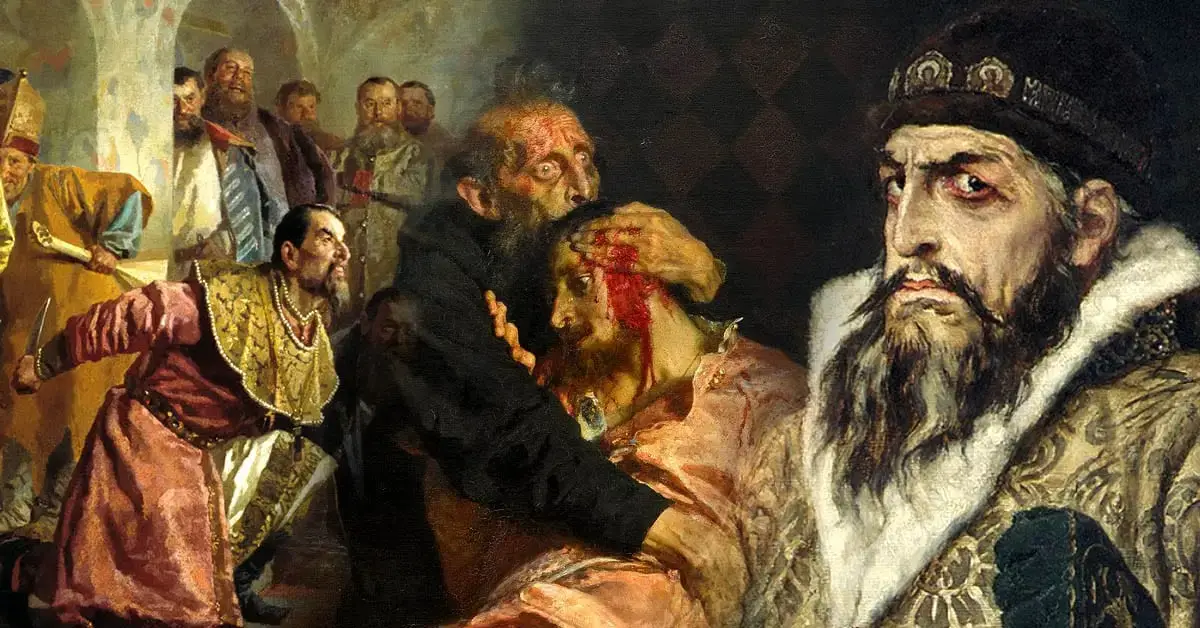Ivan The Terrible And His Son Ivan: Ilya Repin, born in 1844 and dying in 1930, was a celebrated Russian-Ukrainian realist painter. He enjoyed a fruitful and lengthy career, earning widespread recognition for elevating the status of Russian artistic production. One of his most well-known and divisive works is “Ivan the Terrible and his Son.”
Who Was Ivan The Terrible?
The Russian Empire was ruled by Ivan the Terrible, Grand Prince of Moscow, from 1547 to 1584. His intelligence, diplomacy, and widespread support among regular Russians couldn’t hide the fact that he had a reputation for being a bit of a tyrant.
When he got older, his history of temper tantrums only became worse, earning him a reputation as a man who quickly lost his cool. He murdered Ivan Ivanovich, his son and the rightful king, in one breakdown. This seminal event in Russian history inspired the paintings that would become among Ilya Repin’s most renowned.
Ivan the Terrible’s mental health is speculated to have declined over time, making him a potentially dangerous figure for his country by the time of his death. His reign is often cited as a watershed moment in the country’s evolution into an empire, but the transformation would be costly in many ways. Repin’s painting of Ivan immediately after his son’s death is unforgettable due to the artist’s portrayal of Ivan’s grief at losing a child.
Why Was Ivan Nicknamed The Terrible?
Several monikers knew Ivan IV Vasilyevich throughout his life, some of the most notable being “Ivan the Formidable” and “Ivan the Fearsome.” His autocratic leadership style helped inspire decades of unquestioned rule in Russia and contributed to the boldness of his labeling.
It didn’t matter what it took to get his political way; as he got older, he became more violent in pursuing his goals. Hence, epithets like “The Terrible” were mainly due to the hardships he inflicted on his people due to his political judgments.
Others, however, have stated his disposition was considerably more benevolent and that he was the victim of unfair reportage. The modern Russian public, like the western public from which it has drawn most of its ideas, places a high value on a strong leader.

Several plays and novels have been produced on his life, adding to the growing body of mythology surrounding the man known as The Terrible. As of recently, he enjoys the same level of international renown as Alexander Nevsky, Peter the Great, and Joseph Stalin.
Historians generally agree that Ivan’s worst legacy is the heavy taxation he imposed on his people to pay for unending battles to extend their land. His dynasty, the Rurik dynasty, would fall because of the debts incurred from his aggressive actions, and this would set the stage for what would later be known as the Time of Troubles.
The Siege of Kazan (1552), the Russo-Turkish War (1568-1570), the Livonian War, several Russo-Crimean Wars, and the conquest of Siberia all occurred under his leadership. A shortage of men would result from this large number of commitments spread over a long period. His people would become weary of endless crusades that did not affect their material well-being.
Who Was Ivan’s Son?
In 1883–1885 Tsarevich Ivan Ivanovich of Russia, son of Ivan the Terrible, posed for portraits by Repin, which depict his corpse. It is claimed that by the time Ivan the Younger was in his mid to late twenties, he had been dissatisfied by the amount of failed confrontations brought about by his father, Ivan the Terrible, and had begun to speak out against The Terrible’s activities.
After serving together in the military, there was a lot of love and respect, but his father’s rage would eventually kill him. His father was suspected of killing his son on November 19, 1581. While historians’ depictions of his behavior are inconsistent, they generally agree that his father committed the murder.
Growing up in a wealthy family in 16th-century Europe meant that young Ivan was frequently set up in politically advantageous marriages to ladies all over the continent. Young Ivan would wed three times; his first two, Eudoxia Saburova and Praskovia Solova were divorced because they failed to produce children, a strategy employed by his father to ensure his family’s continued rule. Yelena Sheremeteva, his third wife, conceived a child, although she is thought to have miscarried around the time he passed away.
What Is The Meaning of Ilya Repin Painting?
Repin was adept at painting realistic portraits of people and often painted for moral or social causes. The painting Ivan the Terrible and his Son (1885) is a notable departure from his usual style, which did not include historical subjects or scenes of violence and bloodshed. Most people think that Repin painted this to express his disapproval of killing and mayhem.
According to reports, he was moved to write about Russia’s history of tragedy after hearing of Alexander II’s assassination. After several years as a member, the artwork was finally displayed at the 12th Itinerant’s Society Exhibition in St. Petersburg in 1885.
The painting has been met with significant backlash due to its brutal honesty, particularly from more conservative minds who fail to see that it is a warning against violence rather than an attempt to promote it. Because of its increasing divisiveness, the artwork has been attacked several times, most recently in 2018. Please share this with your friends if you find it interesting. Visit Newswatchlist.com for more celebrity updates and breaking news.



Leave a Reply